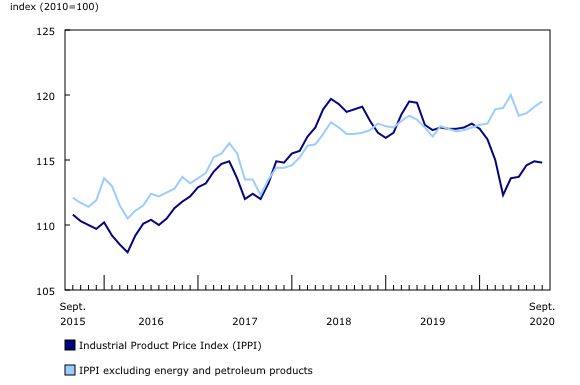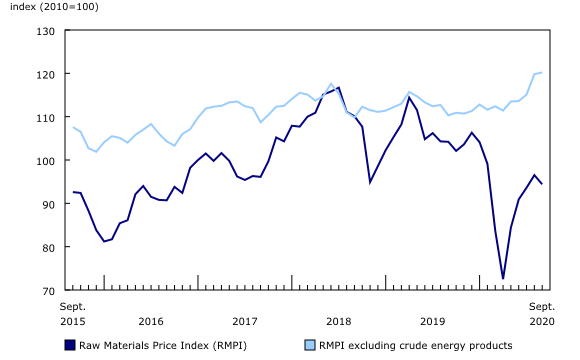Industrial product and raw materials price indexes, September 2020
Archived Content
Information identified as archived is provided for reference, research or recordkeeping purposes. It is not subject to the Government of Canada Web Standards and has not been altered or updated since it was archived. Please "contact us" to request a format other than those available.
Released: 2020-10-30
Prices for products manufactured in Canada, as measured by the Industrial Product Price Index (IPPI), edged down 0.1% in September, led by lower prices for energy and petroleum products. Prices of raw materials purchased by manufacturers operating in Canada, as measured by the Raw Materials Price Index (RMPI), fell 2.2%, pulled downward mainly by lower prices for crude energy products.
Industrial Product Price Index
The IPPI edged down 0.1% in September, following four consecutive monthly increases. Of the 21 major product groups, 9 were down, 10 were up, and 2 were unchanged.
The decrease in the IPPI was largely driven by declining prices for energy and petroleum products (-4.4%), which fell for a second straight month. A widespread decline in prices for refined petroleum products, including motor gasoline (-3.5%), light fuel oils (-8.2%), as well as diesel fuel (-8.1%), pushed this product group downward. The drop in refined petroleum product prices was concurrent with a 7.0% decrease in prices of conventional crude oil.
Excluding energy and petroleum products, the IPPI rose 0.3%, largely driven by higher prices for lumber and other wood products (+6.3%), as well as for meat, fish and dairy products (+1.7%).
In the lumber and other wood products group, softwood lumber prices (+20.7%) continued to rise in September, after posting a 28.6% increase in August. The imbalance between supply and demand for softwood lumber, created by an unexpected increase in construction work and home renovations, was the main contributor to this gain. Higher prices for fresh and frozen pork (+9.7%) drove meat, fish and dairy products upward.
Prices for fruit, vegetables, feeds and other food products (+1.1%) also rose from August. Higher prices for canola oil (+8.9%) and oilseed cake and meal (+9.0%) mainly led this increase.
Primary non-ferrous metal products (-0.4%), fabricated metal products and construction materials (-0.9%) and pulp and paper products (-0.6%) were also among the product groups that saw prices decline in September.
Year over year, the IPPI (-2.2%) decreased for an eighth consecutive month in September, primarily as a result of lower prices for energy and petroleum products (-28.2%).
Raw Materials Price Index
The RMPI fell 2.2% in September, following four consecutive months of increase. The RMPI excluding crude energy products was up 0.3%. Of the six major product groups, three were down and three were up.
The September downturn in the RMPI was driven by lower prices for crude energy products (-6.9%), especially conventional crude oil (-7.0%). Slowed growth in global demand for oil, as well as concerns related to demand—caused by signs of a second wave of the COVID-19 pandemic—contributed to this decline. According to estimates from the U.S. Energy Information Administration, global month-over-month consumption of petroleum rose 1.0 million barrels per day (mbpd) on average in August and September, compared with an increase of 4.1 mbpd from May through July.
Prices for metal ores, concentrates and scrap (-0.6%) also decreased when compared with August. This drop was led by lower prices for precious metal ores and concentrates (-4.9%), especially gold ores, concentrates and mill bullion (-3.8%) and silver ores, concentrates and mill bullion (-7.1%). The decline of prices in this product group was partially offset by higher prices for copper ores and concentrates (+3.0%) and waste and scrap of metal (+3.6%).
Prices for animals and animal products (+1.0%) rose for a second straight month in September, driven upward by higher prices for hogs (+10.2%). Prices for crop products increased 1.5%, led by prices for soybeans (+8.2%) and canola (including rapeseed; +5.1%).
Compared with September 2019, the RMPI fell 9.4%. Prices for crude energy products (-31.8%) were the key contributor to this decline.
Note to readers
The Industrial Product Price Index (IPPI) and the Raw Materials Price Index (RMPI) are available at the Canada level only. Selected commodity groups within the IPPI are also available by region.
With each release, data for the previous six months may have been revised. The indexes are not seasonally adjusted.
The Industrial Product Price Index reflects the prices that producers in Canada receive as goods leave the plant gate. The IPPI does not reflect what the consumer pays. Unlike the Consumer Price Index, the IPPI excludes indirect taxes and all costs that occur between the time a good leaves the plant and the time the final user takes possession of the good. This includes transportation, wholesale, and retail costs.
Canadian producers export many goods. They often indicate their prices in foreign currencies, especially in US dollars, and these prices are then converted into Canadian dollars. In particular, this is the case for motor vehicles, pulp and paper products, and wood products. Therefore, fluctuations in the value of the Canadian dollar against its US counterpart affect the IPPI. However, the conversion to Canadian dollars reflects only how respondents provide their prices. This is not a measure that takes into account the full effect of exchange rates.
The conversion of prices received in US dollars is based on the average monthly exchange rate established by the Bank of Canada and available in table 33-10-0163-01 (series v111666275). Monthly and annual variations in the exchange rate, as described in the release, are calculated according to the indirect quotation of the exchange rate (for example, CAN$1 = US$X).
The Raw Materials Price Index reflects the prices paid by Canadian manufacturers for key raw materials. Many of those prices are set on the world market. However, as few prices are denominated in foreign currencies, their conversion into Canadian dollars has only a minor effect on the calculation of the RMPI.
Upcoming changes: Basket update and methodology changes
Changes will be coming to the IPPI and RMPI with the dissemination of October data on November 30, 2020. The indexes will be converted from 2010 = 100 to January 2020 = 100 and also updated to use a weighting pattern based on the 2016 production values of Canadian manufacturers.
At the same time, the IPPI and RMPI will be modernized with the adoption of a weighted geometric (Jevons) formula and incorporation of parental imputation as the default imputation methodology for missing price quotes.
Commencing with the release of the new basket, the IPPI and RMPI will be released using the North American Product Classification System (NAPCS) Canada 2017 version 2.0 and the North American Industry Classification System (NAICS) Canada 2017 version 3.0. Product indexes will be published at the class (five-digit) level. The current vectors will be terminated, and new tables based on the updated classification systems will appear in the Statistics Canada tables.
Products
Statistics Canada launched the Producer price indexes portal as part of a suite of portals for prices and price indexes. This web page provides Canadians with a single point of access to a variety of statistics and measures related to producer prices.
The video "Producer Price Indexes" is available on the Statistics Canada Training Institute webpage. It provides an introduction to Statistics Canada's producer price indexes—what they are, how they are made and what they are used for.
Real-time table
Real-time table 18-10-0248-01 will be updated on November 9.
Next release
The industrial product and raw materials price indexes for October will be released on November 30.
Contact information
For more information, or to enquire about the concepts, methods, or data quality of this release, contact us (toll-free 1-800-263-1136; 514-283-8300; STATCAN.infostats-infostats.STATCAN@canada.ca) or Media Relations (613-951-4636; STATCAN.mediahotline-ligneinfomedias.STATCAN@canada.ca).
- Date modified:





